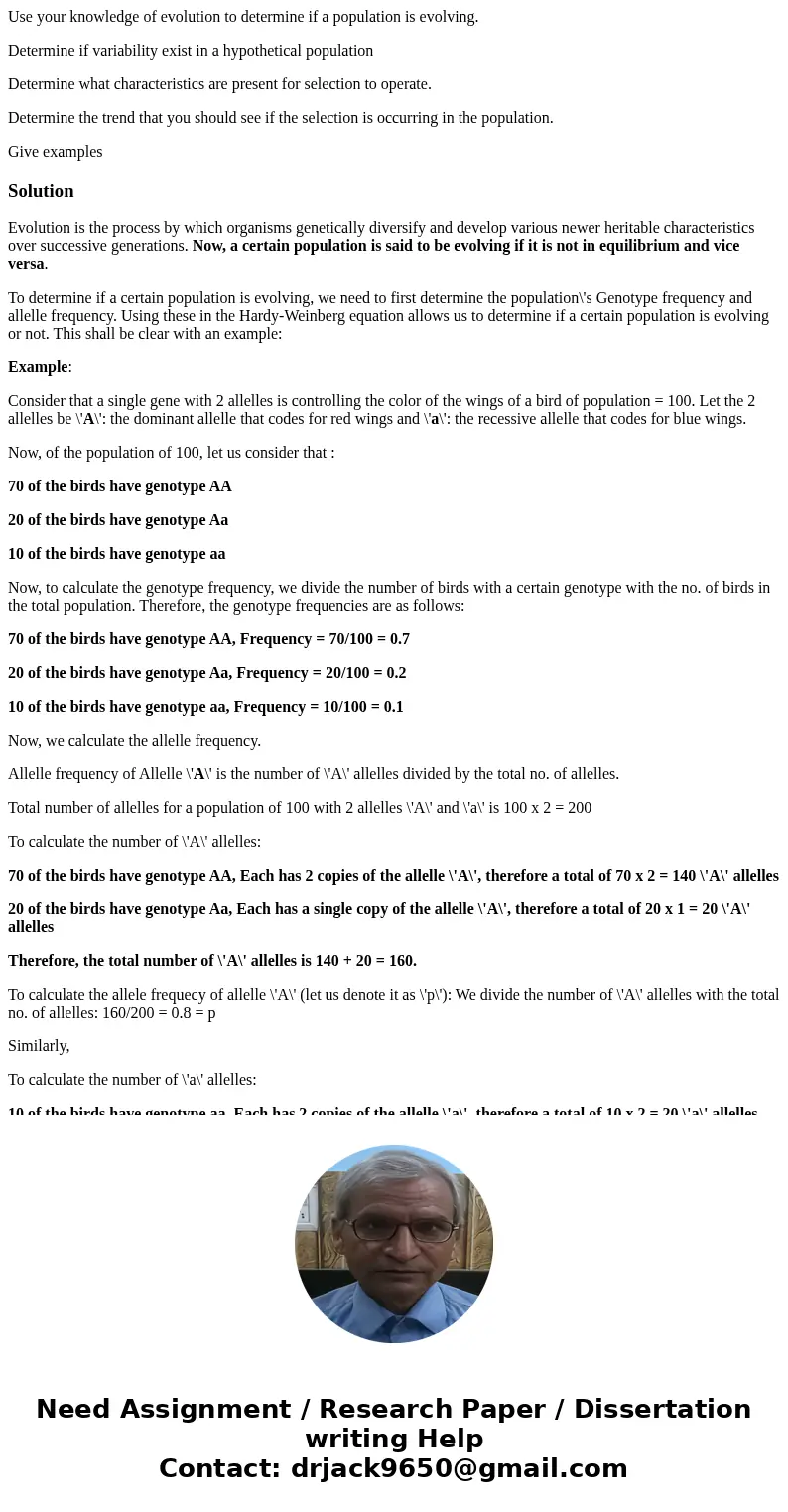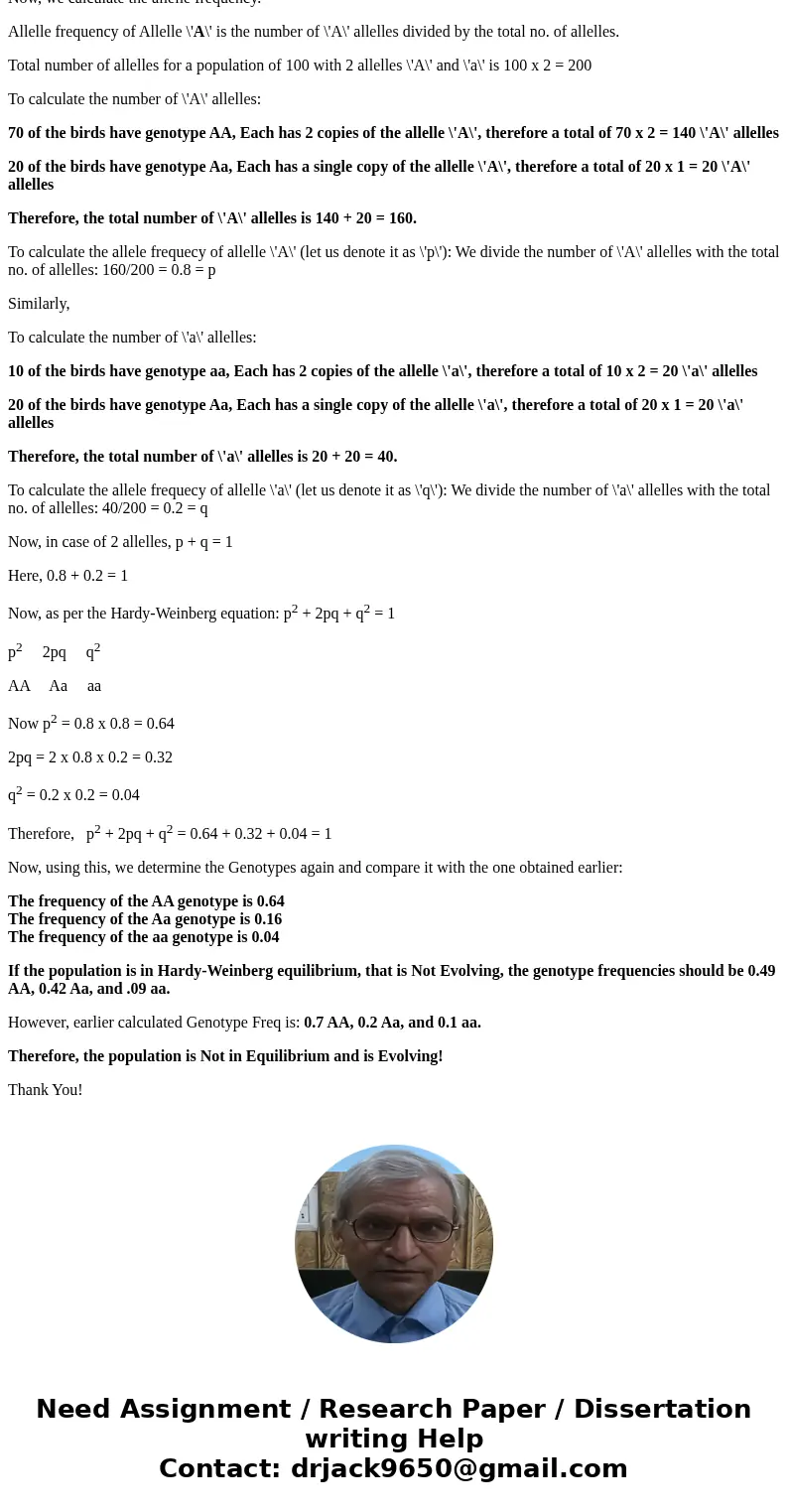Use your knowledge of evolution to determine if a population
Use your knowledge of evolution to determine if a population is evolving.
Determine if variability exist in a hypothetical population
Determine what characteristics are present for selection to operate.
Determine the trend that you should see if the selection is occurring in the population.
Give examples
Solution
Evolution is the process by which organisms genetically diversify and develop various newer heritable characteristics over successive generations. Now, a certain population is said to be evolving if it is not in equilibrium and vice versa.
To determine if a certain population is evolving, we need to first determine the population\'s Genotype frequency and allelle frequency. Using these in the Hardy-Weinberg equation allows us to determine if a certain population is evolving or not. This shall be clear with an example:
Example:
Consider that a single gene with 2 allelles is controlling the color of the wings of a bird of population = 100. Let the 2 allelles be \'A\': the dominant allelle that codes for red wings and \'a\': the recessive allelle that codes for blue wings.
Now, of the population of 100, let us consider that :
70 of the birds have genotype AA
20 of the birds have genotype Aa
10 of the birds have genotype aa
Now, to calculate the genotype frequency, we divide the number of birds with a certain genotype with the no. of birds in the total population. Therefore, the genotype frequencies are as follows:
70 of the birds have genotype AA, Frequency = 70/100 = 0.7
20 of the birds have genotype Aa, Frequency = 20/100 = 0.2
10 of the birds have genotype aa, Frequency = 10/100 = 0.1
Now, we calculate the allelle frequency.
Allelle frequency of Allelle \'A\' is the number of \'A\' allelles divided by the total no. of allelles.
Total number of allelles for a population of 100 with 2 allelles \'A\' and \'a\' is 100 x 2 = 200
To calculate the number of \'A\' allelles:
70 of the birds have genotype AA, Each has 2 copies of the allelle \'A\', therefore a total of 70 x 2 = 140 \'A\' allelles
20 of the birds have genotype Aa, Each has a single copy of the allelle \'A\', therefore a total of 20 x 1 = 20 \'A\' allelles
Therefore, the total number of \'A\' allelles is 140 + 20 = 160.
To calculate the allele frequecy of allelle \'A\' (let us denote it as \'p\'): We divide the number of \'A\' allelles with the total no. of allelles: 160/200 = 0.8 = p
Similarly,
To calculate the number of \'a\' allelles:
10 of the birds have genotype aa, Each has 2 copies of the allelle \'a\', therefore a total of 10 x 2 = 20 \'a\' allelles
20 of the birds have genotype Aa, Each has a single copy of the allelle \'a\', therefore a total of 20 x 1 = 20 \'a\' allelles
Therefore, the total number of \'a\' allelles is 20 + 20 = 40.
To calculate the allele frequecy of allelle \'a\' (let us denote it as \'q\'): We divide the number of \'a\' allelles with the total no. of allelles: 40/200 = 0.2 = q
Now, in case of 2 allelles, p + q = 1
Here, 0.8 + 0.2 = 1
Now, as per the Hardy-Weinberg equation: p2 + 2pq + q2 = 1
p2 2pq q2
AA Aa aa
Now p2 = 0.8 x 0.8 = 0.64
2pq = 2 x 0.8 x 0.2 = 0.32
q2 = 0.2 x 0.2 = 0.04
Therefore, p2 + 2pq + q2 = 0.64 + 0.32 + 0.04 = 1
Now, using this, we determine the Genotypes again and compare it with the one obtained earlier:
The frequency of the AA genotype is 0.64
The frequency of the Aa genotype is 0.16
The frequency of the aa genotype is 0.04
If the population is in Hardy-Weinberg equilibrium, that is Not Evolving, the genotype frequencies should be 0.49 AA, 0.42 Aa, and .09 aa.
However, earlier calculated Genotype Freq is: 0.7 AA, 0.2 Aa, and 0.1 aa.
Therefore, the population is Not in Equilibrium and is Evolving!
Thank You!


 Homework Sourse
Homework Sourse